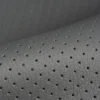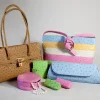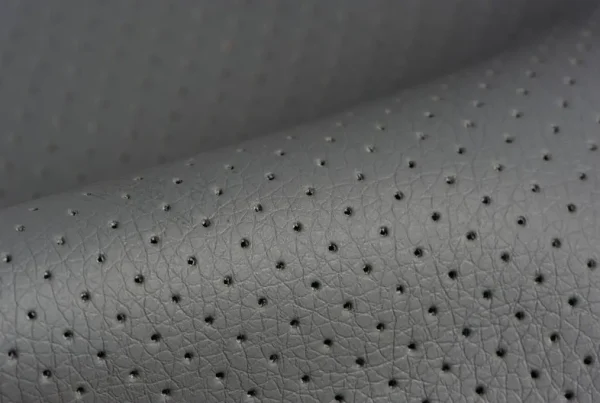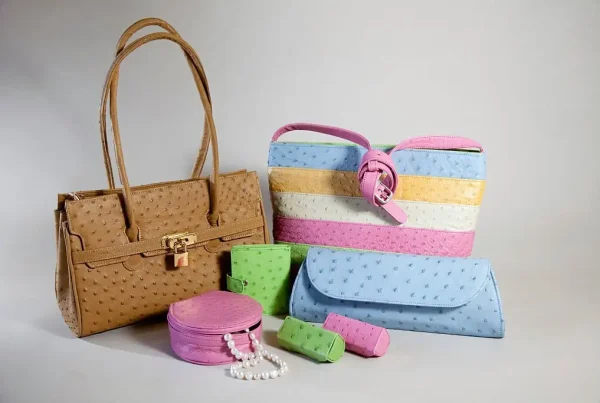Calfskin Leather Intro:
Calfskin leather, as the name suggests, is the leather obtained from the skin of young calves. This leather is cherished for its exceptional quality and is renowned for being one of the finest types of leather available. The soft and smooth texture of calfskin leather sets it apart from other materials.
Historical significance and traditional use
Throughout history, calfskin leather has been held in high regard for its premium status. It has been used for crafting luxurious garments, accessories, and elegant footwear by artisans and fashion houses alike. Its use in creating bespoke gloves and fine bookbindings dates back centuries, showcasing its enduring appeal.
Popularity in modern fashion and accessories
In today’s fashion landscape, calfskin leather continues to maintain its popularity. Leading luxury brands incorporate calf leather into their high-end handbags, wallets, and shoes. The versatility of calfskin leather extends beyond fashion, finding its way into upholstered furniture, giving it a touch of sophistication.
With its smooth surface and sleek appearance, calfskin leather has become synonymous with luxury and refined taste. Its popularity is driven not only by its intrinsic qualities but also by the craftsmanship and skill required to work with this exquisite material. As we delve deeper, we will explore the intricate process of creating calfskin leather and discover why it remains a timeless choice in the realm of fine leather products.
How Calfskin Leather is Made
1. Sourcing raw materials: calf hides
The journey of calfskin leather begins with the careful selection of calf hides. These hides are sourced from young calves, typically less than 12 months old, as they possess a fine grain and a supple texture that is ideal for creating premium leather products. Ethical considerations are crucial in the sourcing process to ensure the welfare of the animals.

2. Tanning process
Once the calf hides are obtained, they undergo a complex tanning process to transform raw hides into the exquisite calfskin leather we know and love.
Vegetable tanning
Vegetable tanning is a traditional and environmentally friendly method that utilizes tannins derived from plants. The hides are immersed in a mixture of water and natural tannins, gradually absorbing the compounds. This process not only enhances the leather’s durability but also gives it a warm, natural tone that develops a beautiful patina over time.
Chrome tanning
On the other hand, chrome tanning is a modern and widely-used method that employs chromium salts. This process is faster and more cost-effective, resulting in a soft, flexible, and water-resistant leather. Chrome-tanned calfskin leather often boasts a wide range of vibrant colors and is commonly used in contemporary fashion and accessories.
Both vegetable tanning and chrome tanning methods contribute to the distinctive qualities of calfskin leather, offering consumers a choice between traditional craftsmanship and modern versatility. The tanning process is an essential step in achieving the desired characteristics of calfskin leather, ensuring it remains a highly sought-after material for premium leather goods.
3. Finishing techniques and dyeing
After the tanning process, calf skin leather undergoes various finishing techniques and dyeing processes to enhance its appearance and functionality.
Finishing techniques involve adding a protective layer to the leather’s surface, which not only improves its resistance to scratches and stains but also enhances its overall feel. Common finishing methods include polishing, buffing, and embossing. Polishing creates a smooth and glossy surface, while buffing enhances the natural grain pattern, accentuating its elegance. Embossing involves stamping decorative patterns onto the leather, adding a touch of uniqueness to each product.
Dyeing is another essential step in the production of calf leather. It allows artisans to imbue the leather with a wide spectrum of vibrant colors, further expanding its application in fashion and interior design. Dyes can be applied uniformly for a sleek look or with variations to achieve a distressed or vintage appearance.
Distinctive Qualities of Calfskin Leather
Calf skin leather boasts an array of remarkable qualities that make it a preferred choice for luxurious goods.
1. Supple and soft texture
One of the most distinctive features of calf leather is its buttery soft texture. It feels smooth and velvety to the touch, providing a luxurious sensory experience.
2. Lightweight and flexible nature
Compared to other types of leather, calf skin leather is relatively lightweight and highly flexible. This characteristic makes it an excellent material for crafting comfortable accessories and apparel that mold effortlessly to the wearer’s body.
3. High durability and longevity
Despite its softness, calfskin leather is surprisingly durable and long-lasting. When properly cared for, products made from calfskin leather can withstand the test of time, maintaining their pristine condition for years.
4. Elegant and refined appearance
Calf skin leather exudes an air of elegance and sophistication. Its fine grain pattern and smooth surface contribute to its refined appearance, making it a popular choice for high-end fashion items and luxury accessories.
Uses of Calfskin Leather
Calf leather finds a wide range of applications across various industries, owing to its luxurious and versatile properties.
1. Luxury fashion industry
In the realm of high fashion, calfskin leather reigns supreme. Leading fashion houses utilize this premium material to craft sophisticated garments like jackets, skirts, and dresses, as well as exquisite footwear that exudes elegance and comfort.
2. Premium leather accessories
Calf skin leather lends itself perfectly to premium accessories, such as handbags, wallets, belts, and gloves. Its supple texture and refined appearance add a touch of opulence to these accessories, making them coveted items for fashion enthusiasts.
3. Upholstery and furniture
When it comes to interior design, calfskin leather enhances the appeal of upholstered furniture, offering a luxurious and inviting touch. From classic armchairs to contemporary sofas, calf leather elevates the ambiance of any space.
4. Specialty leather goods
Beyond fashion and furniture, calfskin leather finds its way into specialty leather goods. It is used in crafting luxury watch straps, premium bookbindings, and other exclusive items that require a blend of elegance and durability.
In essence, calf skin leather’s versatility and distinctive qualities make it a prized material across industries, elevating the aesthetic and tactile experience of various products. Its enduring popularity in the luxury market speaks to its timeless allure and enduring appeal.
Caring for Calfskin Leather
Calfskin leather, being a luxurious and delicate material, requires proper care to maintain its pristine condition and longevity.
1. Regular cleaning and maintenance
To keep calf skin leather looking its best, regular cleaning is essential. Gently wipe away any dust or dirt with a soft, damp cloth. Avoid using harsh chemicals or excessive water, as they may damage the leather’s surface. Conditioning the leather with a suitable leather conditioner will help keep it moisturized and prevent it from drying out.
2. Avoiding exposure to extreme conditions
Calfskin leather is sensitive to extreme conditions, such as excessive heat or direct sunlight, which can cause fading and cracking. Similarly, it should be shielded from rain or excessive moisture to prevent water damage. If the leather gets wet, allow it to air dry naturally and avoid using artificial heat sources.
3. Proper storage tips
When not in use, store calfskin leather products in a cool, dry place away from direct sunlight. To retain their shape, stuff handbags or shoes with tissue paper. Using dust bags or covers will protect them from dust and scratches.
Comparison with Other Leather Types
While calf leather boasts remarkable qualities, it is valuable to understand how it compares to other types of leather.
1. Calfskin vs. cowhide leather
Calfskin leather is softer and more supple than cowhide leather, making it more suitable for crafting accessories and garments that require a luxurious feel. Cowhide leather, however, tends to be thicker and more durable, making it ideal for sturdy items like belts and work boots.
2. Calfskin vs. lambskin leather
Calf skin leather is thicker and more durable than lambskin leather, which is known for its exceptionally soft and delicate texture. Calf skin is preferred for items that require both elegance and resilience, while lambskin is commonly used in lightweight and high-end fashion pieces.
3. Calfskin vs. exotic leathers
Exotic leathers like alligator and ostrich offer unique and distinctive textures, but they are generally more expensive than calfskin leather. Calf skin provides a luxurious alternative with a fine grain pattern and a smoother surface.
In conclusion, caring for calfskin leather involves gentle cleaning and maintenance, avoiding extreme conditions, and proper storage. Comparing calfskin with other leather types highlights its specific advantages, ensuring consumers can make well-informed choices when investing in luxury leather products.
How to Identify Calfskin Leather Products
Identifying calf skin leather products amidst a sea of options can be challenging, but there are effective ways to spot them with ease.
1. Price Tag
Genuine full-grain leather items typically come with a higher price, but calf skin leather takes this to an even loftier level, potentially surprising some buyers.
2. Pores
As mentioned earlier, calf leather boasts minuscule pores that are nearly imperceptible. In contrast, regular leather pores are discernible, albeit faintly. This absence of visible pores is a key indicator of authentic calf leather.
3. Texture
To confirm whether the product is genuine calfskin, touch it. Calfskin items exhibit an incredibly soft and supple texture, akin to the smoothness of butter, along with an elasticity seldom found in other leather products.
4. Appearance
Calf leather carries distinct visual traits. In addition to its tiny pores and light grain, it often sports a high polish that allows you to see your reflection, almost like a mirror. Alternatively, some calf skin leather undergoes an antique treatment, achieved by burnishing it with a stain, creating an aged look without actual wear and tear.
Frequently Asked Questions about Calfskin Leather
1. Is calfskin leather more expensive than other types?
Yes, calf skin leather is generally more expensive than some other types of leather. Its high-quality and premium properties contribute to its elevated price point. However, the investment in calf leather products is often worth it due to their superior softness, durability, and refined appearance.
2. Can calfskin leather be used for outdoor items?
While calf skin leather is prized for its elegance, it may not be the best choice for outdoor items. Exposure to harsh weather conditions, such as rain and extreme sunlight, can damage calf leather. It is better suited for indoor use or occasional outdoor outings in fair weather.
3. What colors are available for calfskin leather products?
Calf skin leather products come in a wide range of colors, offering plenty of choices to suit individual preferences and fashion trends. Common colors include classic neutrals like black, brown, and tan, as well as vibrant shades like red, blue, and green.
4. Is calfskin leather suitable for people with allergies?
Calf skin leather is generally well-tolerated, but individual sensitivities may vary. Some people with allergies to animal proteins may experience mild reactions to leather. If you have known leather allergies, it is advisable to perform a patch test or opt for alternative materials like vegan leather.
Conclusion
To conclude, calfskin leather truly shines as a premium and versatile material with unique qualities that fashion and luxury industries highly prize. Its supple texture, lightweight properties, durability, and elegant appearance all contribute to its timelessness in crafting high-end accessories and garments.
In light of calf skin leather’s enduring appeal, it becomes crucial to prioritize sustainable choices and ethical considerations within the leather industry. Although calf leather products might come with a higher price tag, their exceptional quality and timeless elegance make them valuable investments for individuals seeking enduring luxury.






